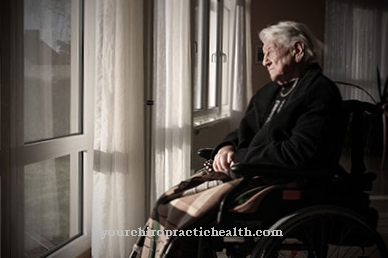Typical sports injuries include the Torn hamstring. It usually occurs in the thigh or calf area. Sprinters and soccer players in particular often suffer from torn muscle fibers, as the high loads on the muscles are particularly evident in these sports. A lack of or insufficient warming up and stretching usually causes the muscle fibers to tear. The result is severe stabbing pain.
What is a torn hamstring?

A Torn hamstring is a sports injury that often occurs in running sports, especially in the thighs or calves. This injury results in a rupture of a muscle fiber bundle and not, as is generally assumed, a rupture of a single muscle fiber.
A muscle fiber tear is comparable to a muscle strain and a muscle tear, whereby the muscle strain is a much lighter and the muscle tear is a significantly more severe injury. Symptoms of a ruptured muscle fiber include sudden, stabbing pain and later persistent pain when tensing the corresponding muscle. If the muscle fiber is torn, there is also bleeding in the muscle, which can be detected by an ultrasound examination.
causes
A Torn hamstring is often caused by movements that are too strong or too abrupt. This can be starting or braking a running movement. The torn muscle fiber is often due to fatigue or overloading of the muscle, which can no longer withstand the strong contractions and stretching.
Insufficient warming up or cold in winter can also serve as causes. If the muscle is not properly prepared for training, there is insufficient blood supply, communication between the muscle and receptors is restricted and the muscle does not react quickly enough. Fundamental muscular imbalances can also cause a torn muscle fiber.
Imbalances exist when a muscle is stronger than its counterpart. Then one muscle has to compensate for the weaknesses of another and is exposed to greater stress. This can then lead to a ruptured muscle fiber.
Symptoms, ailments & signs
A torn muscle fiber manifests itself without warning as an acute, cramp-like pain, similar to a knife or needle stick. The person concerned tries to adopt a gentle posture so as not to stress the torn muscle as much as possible. If the sensation of pain increases sharply through tensing, pressing or stretching a muscle, these are further signs of a muscle fiber tear (usually first degree).
If more than five percent of the muscle fibers are torn, the symptoms intensify through swelling, which usually subside after 24 hours to two days. The formation of a bruise (hematoma) is often the result. Serious muscle fiber tears up to the rupture of muscle bundles are also visible through bleeding when the muscle covering consisting of connective tissue tears and the blood penetrates into the tissue.
The patient feels the immediate loss of strength in the muscle so that it can only be active to a very limited extent and the sequence of movements is impaired. In addition, a torn muscle fiber (from grade II) can also be detected by palpation. As an indication, a dent up to the point of bulging is evident because the muscle parts contract towards the tendon ends. The exact interpretation of the symptoms and the intensity of the injury should be examined by a doctor.
Course of disease
After a Torn hamstring If possible, the muscle should not be strained, as it needs time for the muscle fibers to grow together. A torn muscle takes about 4-7 weeks to heal, with differences depending on the athlete and the torn muscle.
An improvement should be noticeable after a few days or weeks. The muscle feels stronger again, becomes more resilient and the ability to stretch slowly increases. However, scars develop in the muscles, which can lead to limited elasticity of the muscle in the long term.
If the muscle is not sufficiently spared after a muscle fiber tear, ossification can occur. These develop from bruises and are mostly based on incorrect treatment after the muscle fiber tear.
Complications
A torn muscle fiber is a clinical picture that is associated with various complications. As a rule, a torn muscle fiber results from overloading the corresponding muscle. The affected person is particularly disturbed in the sequence of movements, since such a muscle fiber tear is very painful. Sharp pains can also occur in the respective body region when the patient is resting.
Under certain circumstances, inflammation can even develop if the affected area continues to be stressed. In particularly bad cases, an abscess that is filled with pus fluid forms. Such a build-up of pus can cause various other complications. If this fluid gets into the bloodstream, it may even cause blood poisoning.
An infection can also develop in this way. Severe headaches, fever and body aches are the result. If you want to avoid these complications, you should seek medical treatment at an early stage. By taking appropriate medication, healing can take place quickly and complications do not even occur.
The following applies: A muscle tear may be associated with various complications, which should always be treated appropriately by a doctor. Otherwise there is a risk of permanent consequential damage, so that a full recovery is no longer possible.
When should you go to the doctor?
The ruptured muscle fiber is an injury that in many cases heals without the treatment of a doctor. This is especially true if only small areas are affected, so the crack is not too pronounced. Spontaneous healing occurs here simply by protecting and, if necessary, cooling the affected muscles. However, there are a few reasons why going to the doctor is advisable.
This includes, for example, severe pain that cannot be relieved by cooling or painkillers. A large hematoma, an accumulation of blood in the tissue, is also a reason to see a doctor. This is especially true if the bruise does not seem to diminish over time or even encapsulates, which can be felt as a hardening even by laypeople.
It is also possible that a hemorrhage presses on a blood vessel or nerve and exerts compression there. This can lead to an undersupply of the tissue. Therefore, numbness or a tingling sensation are reasons for going to the doctor. Severe pain can also indicate that it is not a torn muscle fiber, but a torn muscle bundle that should be treated by a doctor. If the injury was caused by a fall or a blow, the medical professional can also determine whether a tendon, ligament, or bony structure is involved.
Treatment & Therapy
Treatment for one Torn hamstring differs depending on the severity of the injury and the general physical condition of the injured person. The first aid takes place according to the PECH scheme. Accordingly, breaks, ice, compression (pressure bandage) and elevation are used in the event of a muscle fiber tear. This prevents heavy bleeding and swelling. These immediate measures can also be decisive for the further success of the treatment and the duration of the injury.
In the following days, the muscles should be spared extensively. If there is a torn muscle fiber in the leg, armrests make walking easier. There are also cold treatments and exercises for muscle relaxation. The exercises also ensure that muscle strength is maintained. Special tape dressings that help the muscle fibers grow together can also be beneficial for healing after a muscle fiber tear.
Whether an operation makes sense is determined individually. As a rule, however, an operation is only performed if a large part of the muscle fiber bundle is torn, making it impossible for the muscle fibers to grow together naturally in the event of a severe muscle fiber tear.
Outlook & forecast
The prognosis for a ruptured muscle fiber is usually very good. Depending on the severity, the injury usually heals on its own and completely within two to four weeks, provided the injured muscle is spared. In the case of a ruptured muscle bundle or muscle, it may take longer to heal (up to two months).
Various measures have a healing effect. Immediate protection and elevation of the muscle prevents excessive bleeding. Heat should also be avoided. Care should be taken to adhere to the closed season, as otherwise further muscle injuries can occur. This can unnecessarily delay healing or significantly worsen the initial situation.
Specific physiotherapy and subsequent physiotherapy also have a beneficial effect on healing. The muscle is strained carefully and with increasing intensity in order to restore the original functionality.
Complications are rare and actually only occur when the muscle is overused again prematurely. In this case, too, the prognosis is still good if the patient adheres to the measures described. Muscle tissue is very regenerative, so that permanent damage can almost always be ruled out.
Aftercare
Good follow-up treatment is particularly important when there is a pronounced torn muscle fiber. Even severe fiber tears heal after a few months, but the scar tissue that develops appears to be shorter. It is also less stretchable than normal muscle tissue. Due to different elongation properties, there is also the risk of renewed muscle fiber tears.
However, this risk can be counteracted through rehabilitation measures that can be individually tailored. To do this, the patient performs isometric exercises. This is followed by coordination and movement training. In the course of the follow-up treatment, the muscles are further loaded step by step, for example through sporting activities such as swimming or cycling, which are gentle on the joints and run harmoniously. Ultimately, the sport-specific training can be resumed.
An important rehabilitation measure is physiotherapeutic manual lymph drainage. It has a decongestant effect and combats pain and pressure on the injured part of the body. It can be done a few days after the muscle fiber tear. Light stretching exercises and moderate warmth are also helpful.
It is important that the affected muscle is given enough time to recover. This can avoid complications. It is also important to refrain from alcohol because it weakens the body's defense system and disrupts the healing process. A healthy and protein-rich diet, on the other hand, has a positive effect. Protein is an important building material for the organism.
Aftercare
Good follow-up treatment is particularly important in the case of pronounced muscle fiber tears. Even severe fiber tears heal after a few months, but the scar tissue that develops appears to be shorter. It is also less stretchable than normal muscle tissue. Due to different elongation properties, there is also the risk of renewed muscle fiber tears. However, the risk can be counteracted through rehabilitation measures that can be individually tailored.
To do this, the patient performs isometric exercises. This is followed by coordination and movement training. In the course of the follow-up treatment, the muscles are further loaded step by step, for example through sporting activities such as swimming or cycling, which are gentle on the joints and run harmoniously. Ultimately, you can resume sports training.
An important rehabilitation measure is physiotherapeutic manual lymph drainage. It has a decongestant effect and combats pain and pressure on the injured part of the body. It can be done a few days after the muscle fiber tear. Light stretching exercises and moderate warmth are also helpful.
It is important that the affected muscle is given enough time to recover. This can avoid complications. It is also important to refrain from alcohol because it weakens the body's defense system and disrupts the healing process. A healthy and protein-rich diet, on the other hand, has a positive effect. Protein is an important building material for the organism.
You can do that yourself
If a torn muscle fiber is suspected, sports activity should be stopped immediately in order to limit the damage. The sooner the right measures are taken, the faster the crack will heal.
The injured muscle should be immobilized with a sling or bandage. Then cool down helps against the pain. Moist, cold compresses and ice packs are suitable for this. Important: Ice packs should not come into direct contact with the skin, but should be wrapped in a cloth. Otherwise there is a risk of frostbite. Apply the ice treatment for about 20 minutes. A pressure bandage has a similar effect to cooling with ice. The advantage: the elastic bandage also stabilizes the muscle and restricts mobility. However, the bandage must not be applied too tightly so as not to pinch nerves and blood vessels.
Elevating the affected part of the body will help reduce blood flow to the injured tissue. This will reduce the pain and reduce the swelling. For this reason, warmth should be avoided immediately after the injury, as this stimulates the blood circulation. These measures develop their effect optimally when they are used in combination.



.jpg)























